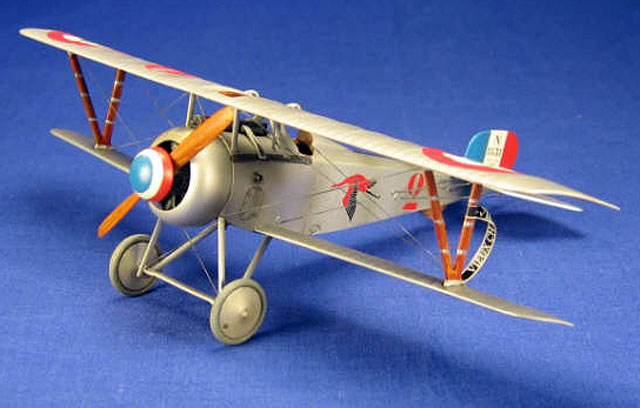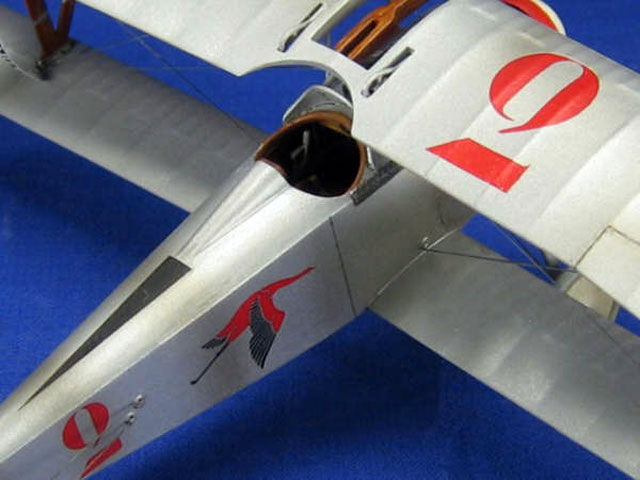|
Eduard's 1/48 scale
Nieuport 17
by
Scott Lyle
|

|
|
Nieuport 17 |

Eduard's 1/48 scale Nieuport 17 is available from
Squadron for less than $9.00!
One of the great fighters of World War I,
the Nieuport 17 entered service during the spring of 1916. It became
known as the “Silver Hawk” for its aluminum dope paint, and it was the
favored mount of many of the great Allied aces including Albert Ball,
Charles Nungesser, and Georges Guynemer. I decided to build one of the
four Nieuport 17s flown by Guynemer, using the markings provided with
the kit.
I built the model basically straight out
of the box and found construction to be very straight forward. Being
such a small aircraft, assembly was quick.

For a biplane there isn’t too much of the
dreaded rigging. I used EZ-Line from Bobe’s Hobby House (it has been
reviewed on this site), which I highly recommend. Since it is elastic,
you can glue it in place in a stretched condition, meaning it is
guaranteed to be perfectly straight. I used to use stretched sprue for
rigging which would never be taut when it was glued in place. I would
then have to light matches and try to “bounce” the sprue to get it to go
taut, but inevitably some would snap, resulting in a fair amount of
frustration. This EZ-Line eliminates all of that, and therefore makes
rigging much less painful!
Paint
 Since
I was going to be painting the entire aircraft silver, I assembled
everything, including the rigging, and left off only the prop, machine
gun, and wheels. I then primed it with Mr. Surfacer 1000 to check for
any flaws I missed during construction. I then sprayed the entire
aircraft Testor's Enamel Aluminum. I was hoping to get the sheet metal
panels around the nose to stand out a bit so I masked them off and
sprayed them with a 50/50 mix of Alclad Aluminum and Dark Aluminum. When
I removed the masking tape however I found that it’s practically
impossible to tell the difference between the Alclad and the Testor
areas! Chock it up to experience - next time I will get the shades of
the colors to have greater contrast. Since
I was going to be painting the entire aircraft silver, I assembled
everything, including the rigging, and left off only the prop, machine
gun, and wheels. I then primed it with Mr. Surfacer 1000 to check for
any flaws I missed during construction. I then sprayed the entire
aircraft Testor's Enamel Aluminum. I was hoping to get the sheet metal
panels around the nose to stand out a bit so I masked them off and
sprayed them with a 50/50 mix of Alclad Aluminum and Dark Aluminum. When
I removed the masking tape however I found that it’s practically
impossible to tell the difference between the Alclad and the Testor
areas! Chock it up to experience - next time I will get the shades of
the colors to have greater contrast.
I brush painted the wood parts using a three-step procedure that I read
about from other modelers online. First the wood parts were painted
Testors Wood. Then Testor's Leather and a small brush were used to paint
wavy lines on them to simulate the grain of the wood. Lastly a generous
coat of Tamiya Clear Orange was used to unify the first two steps,
resulting in realistic looking wood.

The machine gun was painted Tamiya NATO
Black and then dry-brushed with Testors Steel. The rigging wires were
painted Tamiya NATO Black.
I sprayed the entire model with Future to get it ready for the decals,
but the Future did not dry very well, sort of pooling up in areas and
not forming that nice, continuous coat that it always had for me in the
past. While I suspect it didn’t agree with the metallic Testors Aluminum
paint, I’ll be watching the next time to see that it behaves itself!
Decals & Weathering
The kit decals went on flawlessly despite
the less-than-perfect coat of Future. Some Walthers Solvaset got the
decals to sit down over any bumps or recesses.
I glued on the prop, wheels, and machine
gun and sprayed some Testor's Semi-Gloss Coat over the whole aircraft to
seal the decals and tone down the finish.
Using a small brush I used a thin wash of
50/50 Lamp Black/Raw Umber to accentuate the few recessed lines there
were on the Nieuport. I then airbrushed a very then mix of the same
around the flaps, wheels, where the wings and stabilizers meet the
fuselage, and especially around the engine and cowling to add a bit more
grime to the model.

My last step was to mist on a bit of
Tamiya Desert Yellow around the wheels and rear skid to simulate some
dust and dirt.
Whenever I build a biplane model I’m always amazed by how fragile the
real things must have been. For me part of the fun of model building is
learning all about the men and the machines they flew, and this was no
exception. I highly recommend this kit; it’s a fast build with no flaws.
I’m looking forward to tackling some more Eduard biplanes in the future!
-
Osprey Publications, Aircraft of the
Aces #33, “Nieuport Aces of World War 1”
-
Squadron/Signal Publications,
Aircraft in Action #167, “Nieuport Fighters in Action”
-
Wikipedia, the online encyclopedia
Click the thumbnails below to view larger images:
[../../photogallery/photo00017224/real.htm]
Model, Images and
Text Copyright © 2007 by Scott Lyle
Page Created 17 September, 2007
Last Updated 24 December, 2007
Back to HyperScale
Main Page
|
Home
| What's New |
Features |
Gallery |
Reviews |
Reference |
Forum |